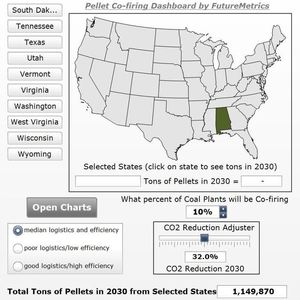FutureMetrics releases dashboard on pellet demand for cofiring




FutureMetrics
September 8, 2015
BY Katie Fletcher
On Sept. 7, FutureMetrics provided a new dashboard analyzing and calculating industrial wood pellet demand for U.S. power plants under various cofiring scenarios.
The dashboard user can select one or many states to analyze with a number of user inputs. The dashboard estimates how many tons of pellets a state—or the number of states the user wishes to select—will demand with coal in their pulverized-coal power plants. The buttons on the left side of the main input page allow those selections. The dashboard allows the user to select from any of the U.S. states for inclusion in a cofiring strategy.
Besides the number of states, the user can change the assumed proportion of power plants that cofire and allow other inputs to be changed to investigate different scenarios. The assumed proportion of power plants that cofire is set at a default 10 percent.
Advertisement
The dashboard includes two chart outputs. One chart shows CO2 reduction by year from 2020 to 2030 and the tons of pellets for cofiring needed to reach those levels of reduction. Based on the user inputs, data on individual states’ forecasted demand for wood pellets in 2030 can be seen by clicking on the state on the map. The ramp up in cofiring rates is set to reach a 32 percent reduction in CO2 emissions by 2030. The final rate of reduction in 2030 can be adjusted.
The second chart in the dashboard shows the historical demand in the selected state or states for the plants that are assumed to be cofiring—default is 10 percent—and the expected coal demand under “business as usual” and under the cofiring scenario.
The efficiency of the power plants influences the cofiring rates. The supply chain logistics for getting the pellets to a power plant influences the carbon footprint and therefore CO2 reduction rates. The dashboard lets the user see the impact of changes in those characteristics.
Advertisement
According to FutureMetrics, “Blending sustainable wood pellets with coal is a proven and reliable strategy for lowering CO2 emissions. The strategy yields the lowest-cost, low-carbon power. The strategy uses existing generating assets with relatively low-cost modifications.”
Further, “Cofiring should be part of the portfolio of compliance strategies for the Clean Power Plan,” FutureMetrics states. The company elaborated on this position in an earlier white paper written on the topic entitled “A rational and pragmatic off-ramp to a decarbonized future.”
Power plant and coal demand data provided in the dashboard is from the U.S. Energy Information Administration. The forecast and analysis is by FutureMetrics. The dashboard can be downloaded here.
Upcoming Events





